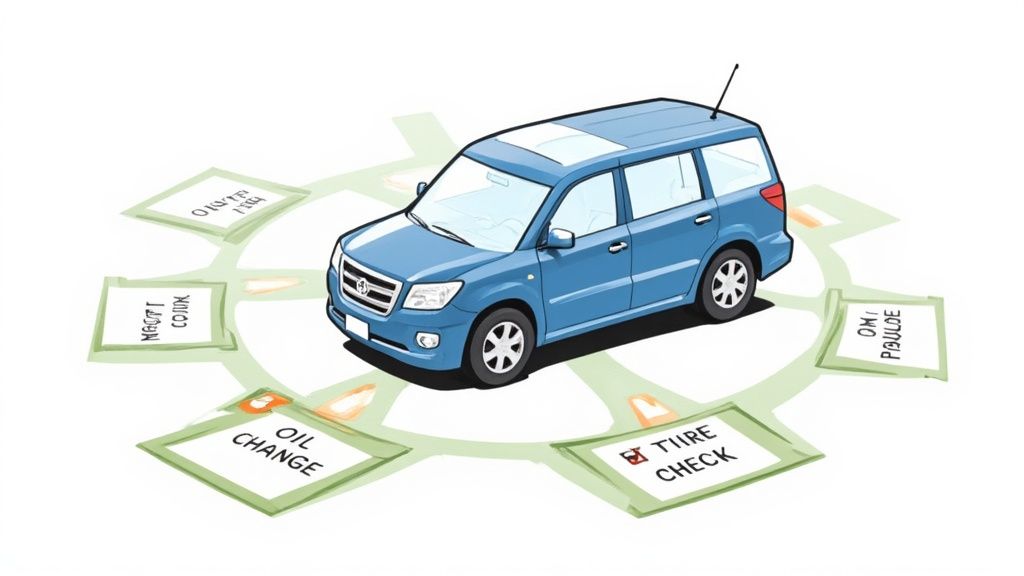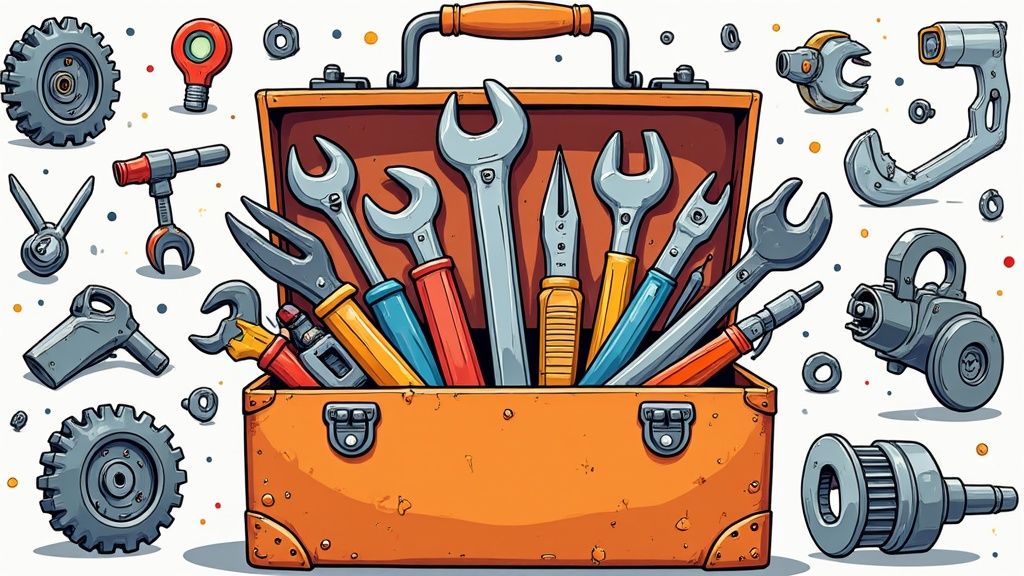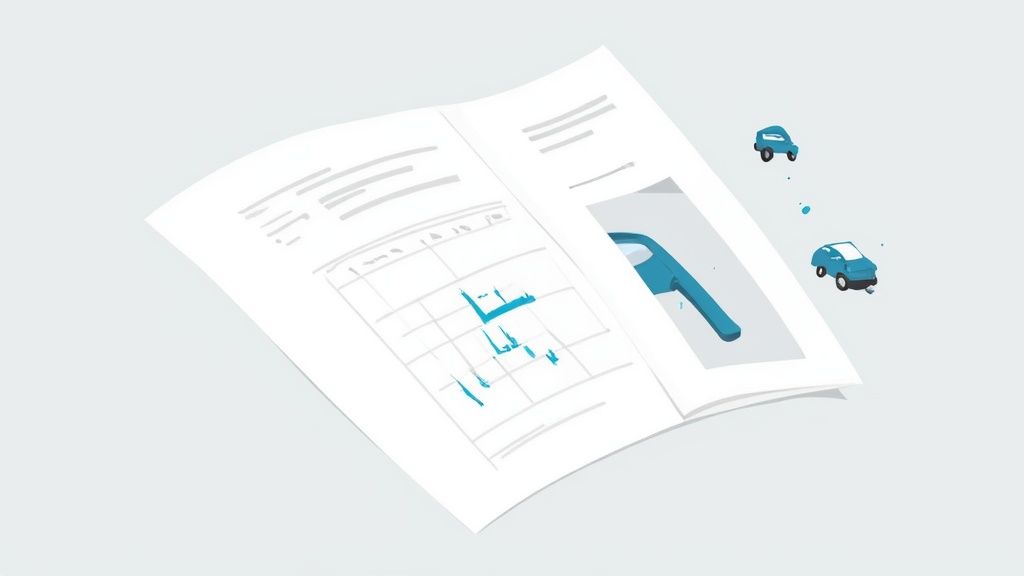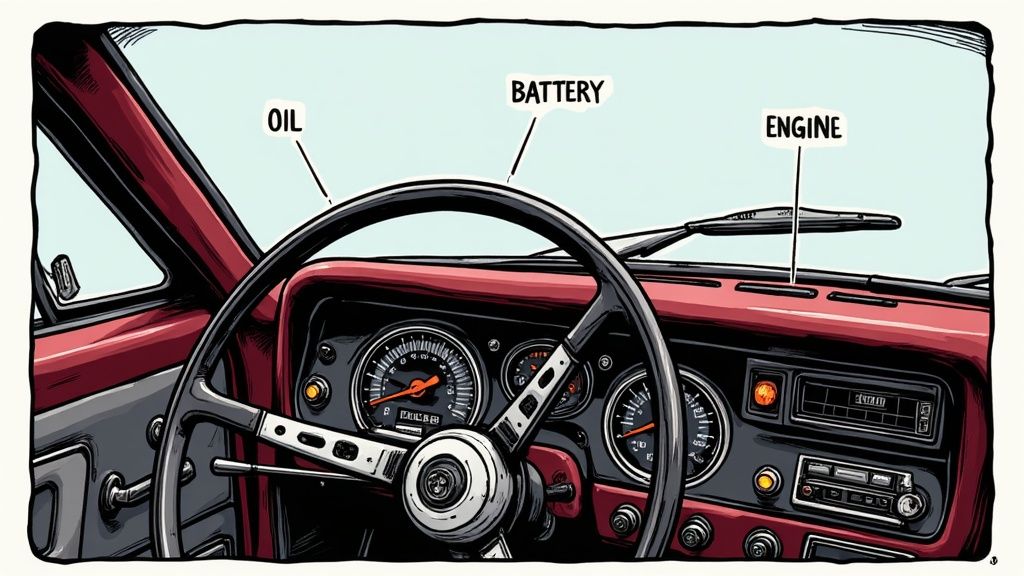
Ultimate Vehicle Maintenance Checklist Template: Transform Your Car Care Strategy
The Hidden Cost of Neglected Vehicle Maintenance

Most car owners don’t realize how much skipping routine maintenance actually costs them in the long run. Recent studies show that 73% of vehicles on the road need critical maintenance work - a troubling statistic that directly leads to higher repair bills and compromised safety. When small maintenance tasks get pushed off, they often spiral into major mechanical problems. Take oil changes for instance - putting off a $50 oil change service can result in engine damage requiring $5,000 or more in repairs.
The Impact on Repair Costs and Resale Value
Regular maintenance doesn’t just prevent expensive repairs - it also helps preserve your vehicle’s value over time. According to CARFAX, cars with documented maintenance records sell for an average of $330 more than similar vehicles without service records. Just like maintaining a home increases its market value, keeping up with vehicle maintenance protects your car’s worth. The data clearly shows that following a maintenance schedule is a smart financial move.
The Importance of a Structured Maintenance Program
Professional fleet managers understand the financial benefits of systematic maintenance firsthand. By implementing thorough maintenance programs and checklists, they save around $3,200 per vehicle each year. These savings come from multiple sources - avoiding major repairs, getting better fuel economy, reducing vehicle downtime, and extending how long vehicles stay in service. Having a detailed maintenance checklist helps catch problems early before they become expensive emergencies.
Extending Vehicle Life Through Proper Tracking
Keeping detailed maintenance records has a major impact on how long a vehicle lasts. Proper documentation proves responsible ownership and provides insights into the vehicle’s condition over time. Many owners report extending their vehicles’ lifespans by up to 50% simply by following maintenance schedules and tracking all services performed. This organized approach leads to fewer breakdowns and repairs. By identifying and fixing small issues during regular maintenance checks, drivers prevent minor problems from becoming major headaches. The result is less time in the repair shop and a vehicle that runs reliably for many more years. Making the effort to maintain good service records is one of the best investments you can make in your vehicle’s longevity and value.
Building Your Smart Maintenance Strategy
Taking care of your vehicle doesn’t have to be overwhelming. With a well-planned approach, you can turn vehicle maintenance from a reactive headache into a smooth, organized process. Professional fleet managers who oversee hundreds of vehicles have proven that systematic preventive care leads to significant cost savings over time. Let’s explore how to build these essential maintenance habits into your daily, weekly, and monthly routines.

Daily Checks: The Foundation of Prevention
Think of daily vehicle checks like brushing your teeth - a quick but essential habit that prevents bigger problems. These brief inspections often take less than 60 seconds but can catch issues before they become serious. Your daily checklist should include:
- Tire Pressure: Keeping tires properly inflated is crucial for safe driving and fuel efficiency. Under-inflated tires waste gas and could lead to dangerous blowouts.
- Fluid Levels: A quick check of oil, coolant, and brake fluid can help prevent engine damage.
- Lights: Make sure all lights work properly for safety and visibility.
For instance, catching a slow tire leak during your morning check could prevent a dangerous blowout later. This simple daily habit could save you hundreds in towing fees and tire replacement costs, not to mention keeping you safe.
Weekly Checks: Catching Issues Early
Building on your daily routine, weekly inspections dig a little deeper into your vehicle’s condition. Keep these tasks on your maintenance checklist:
- Brake Check: Listen for unusual noises and test brake responsiveness.
- Battery Health: Verify your battery is charging properly.
- Windshield Wipers: Check that wipers clear your windshield effectively.
Even if daily checks seem fine, weekly tire pressure monitoring ensures consistent performance. Research shows this kind of regular maintenance reduces unexpected repairs by up to 35%.
Monthly Checks: The In-Depth Analysis
Monthly inspections provide time for thorough evaluation, similar to what professional fleet managers perform. These checks focus on components that need less frequent attention but are still vital for your vehicle’s health. Include these tasks in your monthly routine:
- Suspension Parts: Check for wear signs like leaks or unusual sounds.
- Belts and Hoses: Look for cracks, fraying, or fluid leaks.
- Fluid Top-Offs: Even if levels look good weekly, monthly refills ensure optimal performance.
This thorough approach helps identify potential problems early, saving money and providing confidence in your vehicle’s condition. The key is consistently following your maintenance checklist, customized to your specific vehicle’s needs.
Mastering the 30-60-90 Maintenance Framework
Car maintenance requires a systematic approach that extends beyond basic upkeep. The 30-60-90 maintenance framework offers a proven way to care for your vehicle at key mileage milestones - 30,000, 60,000, and 90,000 miles. By following this schedule, you can catch potential issues early and maintain your car’s performance over time. Professional mechanics rely on this framework because it aligns with how vehicle components naturally wear and need service.

The 30,000-Mile Mark: Essential Upkeep
The 30,000-mile service represents your first major maintenance checkpoint. At this stage, mechanics focus on replacing vital fluids and inspecting key components. Fresh engine oil and coolant help protect the engine, while a thorough brake inspection ensures safe stopping power. For instance, brake pads often need replacement around this time before they can damage the rotors. Using a vehicle maintenance checklist helps track these important service items and prevent small problems from growing into expensive repairs.
The 60,000-Mile Mark: In-Depth Inspection
When your odometer hits 60,000 miles, your car needs more extensive attention. This service typically includes replacing spark plugs and transmission fluid, along with a detailed inspection of the suspension system. Tire wear patterns should be evaluated, and rotation or replacement may be needed. Regular tire maintenance at this stage, as documented in CARFAX reports, plays a key role in extending tire life and maintaining vehicle safety.
The 90,000-Mile Mark: Preemptive Maintenance
At 90,000 miles, preventative maintenance becomes critical. Your mechanic should inspect the timing belt or chain, replace the serpentine belt, and thoroughly check all fluids and hoses. Following a detailed vehicle maintenance checklist during this major service helps identify parts showing wear before they fail. Taking care of these items helps maintain reliable performance even as your car accumulates higher mileage.
Adapting the Framework to Your Driving Style
While the 30-60-90 framework provides excellent guidelines, your specific driving patterns may require adjustments. For example, frequent towing or harsh weather exposure might mean more frequent maintenance checks. City drivers dealing with constant stop-and-go traffic typically need more frequent brake service. Highway drivers, on the other hand, may be able to extend their oil change intervals. Tools like Auto Service Logger can help you track maintenance and adjust schedules based on your car’s actual needs. By understanding how you use your vehicle and monitoring its condition, you can customize the maintenance timeline to maximize performance and longevity.
Crafting Your Perfect Vehicle Maintenance Checklist Template

Regular vehicle maintenance is essential for keeping your car running smoothly and avoiding expensive repairs. Creating an organized checklist helps track all necessary maintenance tasks systematically. Let’s explore how to build an effective vehicle maintenance checklist that works for your specific needs.
Essential Elements of a Vehicle Maintenance Checklist Template
A practical vehicle maintenance checklist should cover all important systems while remaining simple to use. Here are the key components to include:
-
Daily Checks: Quick visual inspections form the foundation of good maintenance habits. For example, checking tire pressure each morning can prevent dangerous blowouts. Place these basic checks at the top of your checklist for easy reference.
-
Weekly Checks: These more detailed inspections build on daily tasks. Testing brakes and checking battery connections help catch problems early. Studies show that consistent weekly maintenance can reduce unexpected repairs by 35%.
-
Monthly Checks: Once a month, take time for thorough inspections of suspension parts, belts, and hoses. Monthly checks give you a complete picture of your vehicle’s condition and help prevent major issues.
-
Mileage-Based Service: Professional mechanics use the 30-60-90 maintenance schedule as their guide. Including these key mileage milestones ensures you don’t miss critical services as your odometer climbs.
-
Record Keeping: Document dates, mileage, and details for all maintenance work. Good records prove valuable when diagnosing problems or selling your car. According to CARFAX, vehicles with detailed service histories sell for $330 more on average.
Structuring Your Vehicle Maintenance Checklist Template
A clear table format works well for organizing maintenance tasks. This layout makes it easy to track what needs to be done and when:
| Task | Frequency | Date Completed | Mileage | Notes |
|---|---|---|---|---|
| Check Tire Pressure | Daily | |||
| Check Fluid Levels | Daily | |||
| Check Lights | Daily | |||
| Inspect Brakes | Weekly | |||
| Check Battery Health | Weekly | |||
| Inspect Wiper Blades | Weekly | |||
| Check Suspension | Monthly | |||
| Inspect Belts/Hoses | Monthly | |||
| Oil Change | 30k Miles |
Consider using Auto Service Logger to digitally track your maintenance records and get automatic reminders. A well-organized checklist combined with consistent follow-through helps maintain your car’s value and reliability for years to come.
Customizing Your Template for Maximum Impact
Every vehicle has unique needs that require a personalized maintenance approach. While basic templates offer a good foundation, crafting a maintenance checklist that fits your specific vehicle and driving patterns is essential for keeping it running smoothly. By carefully considering factors like your vehicle’s type, age, and usage, you can create a maintenance plan that prevents costly repairs and extends your vehicle’s life.
Adapting to Vehicle Type and Age
Different vehicles have distinct maintenance requirements based on their design and purpose. For example, a heavy-duty truck needs more frequent suspension and brake system checks due to carrying heavy loads. In contrast, an electric vehicle requires specialized attention to components like battery packs and electric motors. Age is another crucial factor - older vehicles typically need more frequent inspections as parts naturally wear down over time. Your maintenance checklist should evolve alongside your vehicle, adding more checks and preventive tasks as it ages.
Factoring in Usage and Driving Conditions
How you use your vehicle greatly influences its maintenance schedule. A car used for daily city commuting experiences more stress on brakes and transmission compared to one used mainly for weekend drives. For instance, delivery vehicles covering thousands of weekly miles need more frequent oil changes and brake inspections than occasionally driven cars. Environmental factors also play a key role - extreme temperatures and rough terrain can speed up wear and tear. If you regularly tow heavy loads, you’ll want to check transmission fluid and cooling systems more often. Tools like Auto Service Logger can help track these specialized maintenance needs.
Specialized Templates and Examples
Different vehicles require unique maintenance approaches based on their purpose. High-performance sports cars driven aggressively need frequent tire, brake, and oil checks. Electric vehicles focus more on battery health, charging systems, and cooling maintenance. Off-road vehicles require regular inspections of suspension components, four-wheel-drive systems, and undercarriage protection. These examples show how maintenance templates must adapt to serve different vehicle types and uses effectively.
By tailoring your maintenance checklist to your specific situation, you can spot potential issues early and address them before they become serious problems. This proactive approach helps protect your investment, ensures your safety, and keeps your vehicle running reliably for years to come.
Making Maintenance Work Smarter with Technology
A well-designed vehicle maintenance checklist is essential, but adding digital tools takes car care to the next level. By combining traditional inspection methods with modern technology, you can build a reliable system that helps track and manage maintenance more effectively over time.
Benefits of Digital Vehicle Maintenance Checklists
Moving maintenance tracking to digital platforms provides clear advantages for car owners. You can instantly pull up your complete service history, get automatic reminders before maintenance is due, and generate detailed reports for taxes or selling your vehicle. Studies show that digital maintenance tracking typically reduces yearly costs by 23% and can boost resale value by 15%. For most owners, this makes digital maintenance tracking a worthwhile investment.
Finding Your Ideal Maintenance Tools
There are many great options for tracking vehicle maintenance digitally. The key is choosing a solution that fits your specific needs. Popular choices include dedicated car maintenance apps that handle service logging, reminders, and expense tracking. Microsoft Excel and other spreadsheet programs also work well for creating custom maintenance checklists. The most important factor is selecting a system you’ll actually use consistently.
Real Success Stories with Digital Tracking
Car owners who embrace digital maintenance tracking often see impressive results. Take John’s experience - he carefully documented every service and repair for his truck using a maintenance app. When selling, he provided potential buyers a complete digital maintenance history that proved his truck’s excellent care. This transparency helped him command a higher price and find a buyer quickly. Stories like this show how digital records create real value.
Managing Maintenance with Auto Service Logger
Auto Service Logger offers a practical solution for vehicle maintenance tracking. This platform provides a central hub for all maintenance records, eliminating paper files. Features like mileage tracking and custom reporting make it simple to stay on top of maintenance needs. The secure cloud storage ensures your records are always safe and accessible.
The digital approach doesn’t just make maintenance tracking easier - it helps you take better care of your vehicle. By spotting potential issues early through consistent tracking, you can avoid expensive repairs down the road. Professional fleet managers use similar principles to optimize their maintenance programs, and you can apply the same smart approach to your personal vehicle maintenance.
Ready to experience simpler vehicle maintenance? Start your free trial with Auto Service Logger today at https://autoservicelogger.com/.